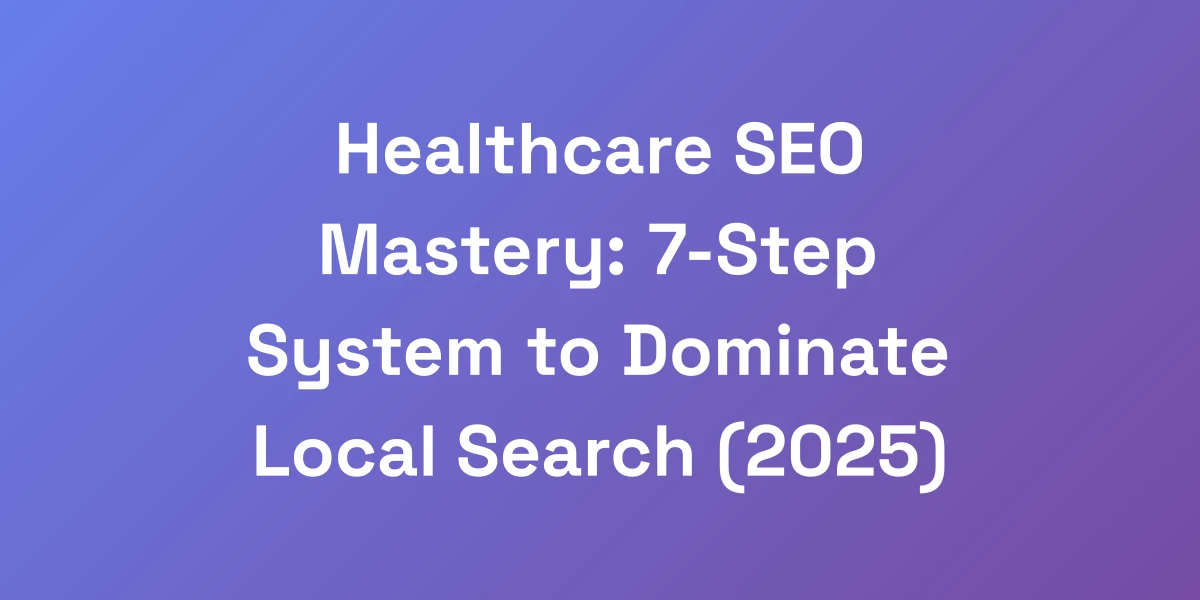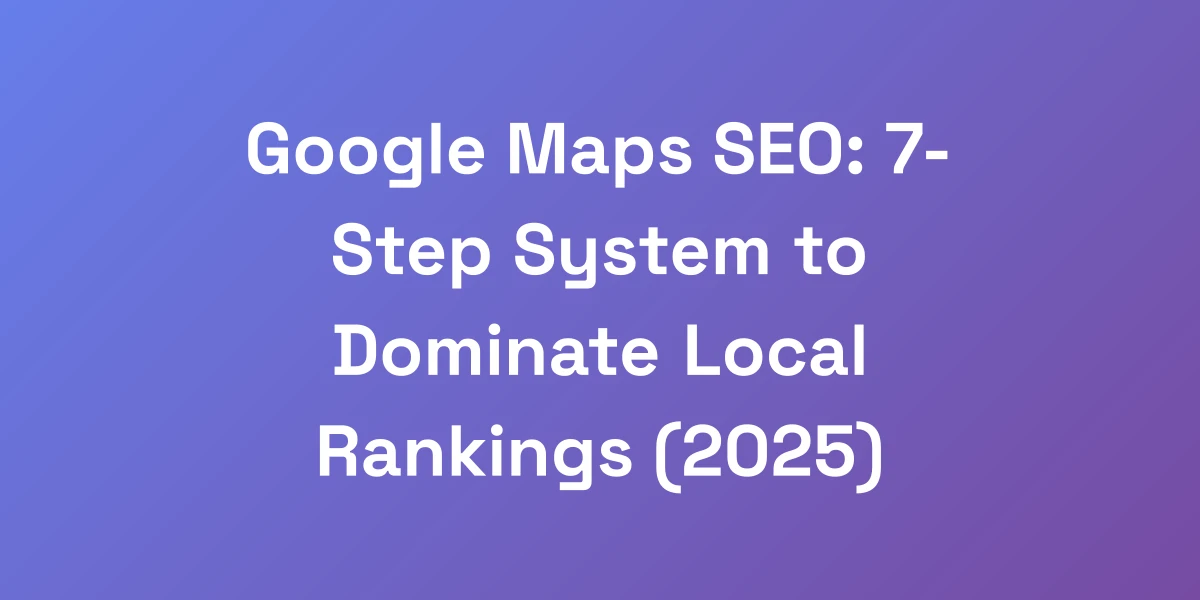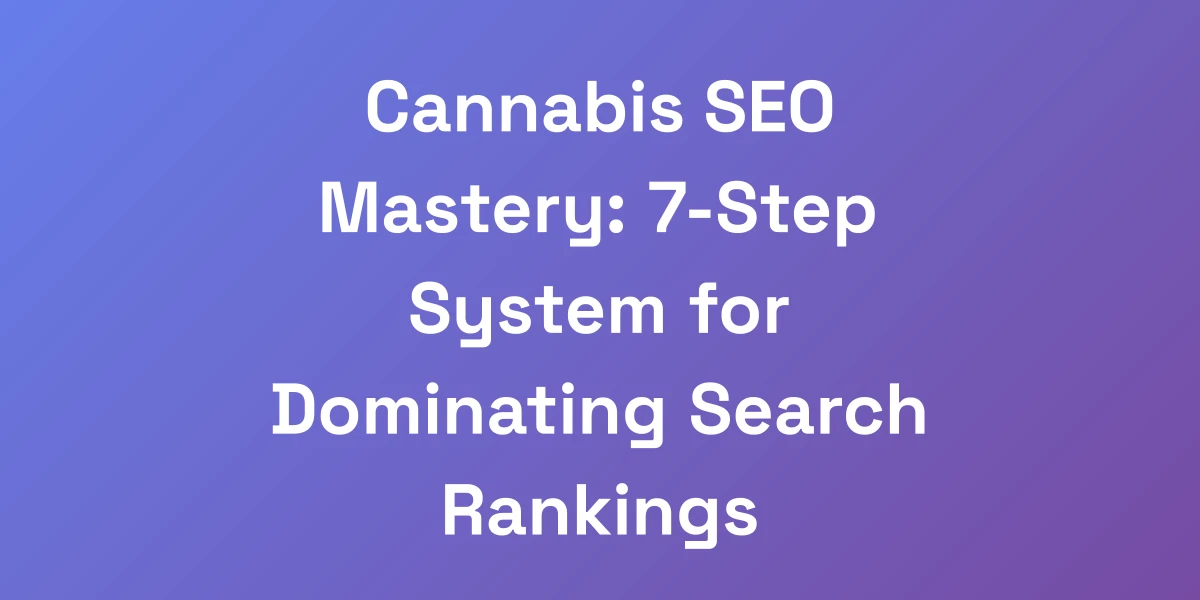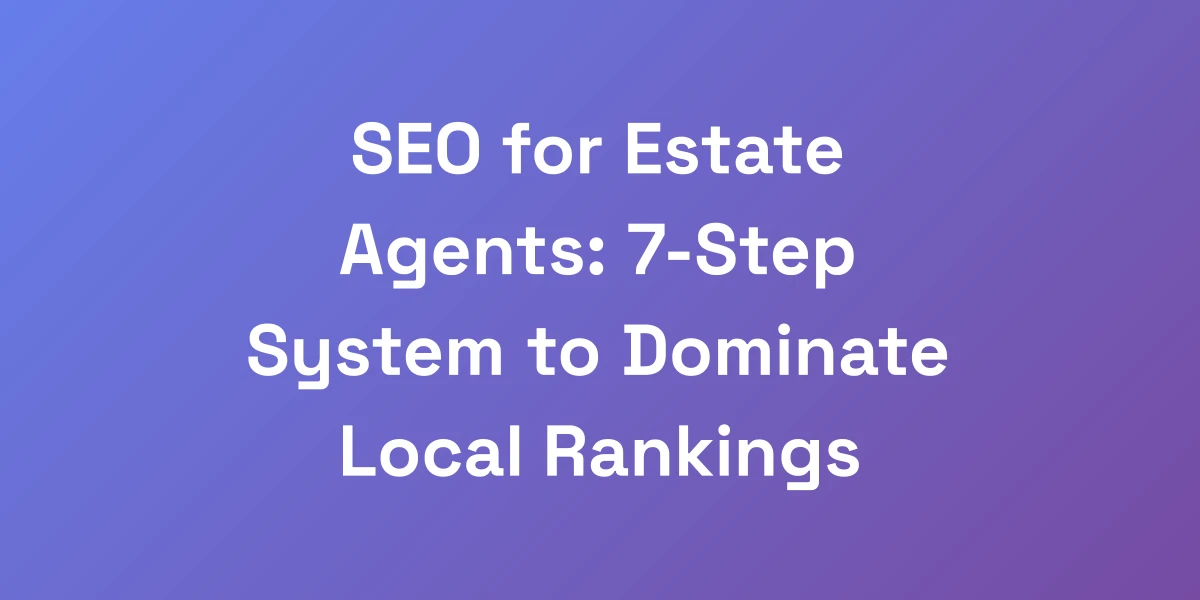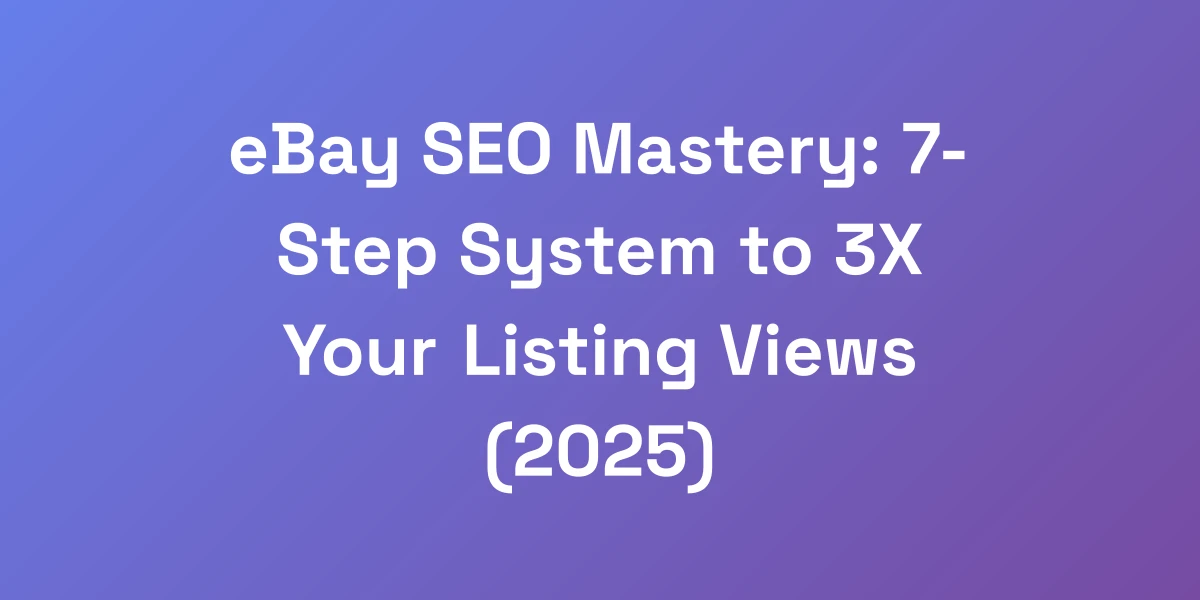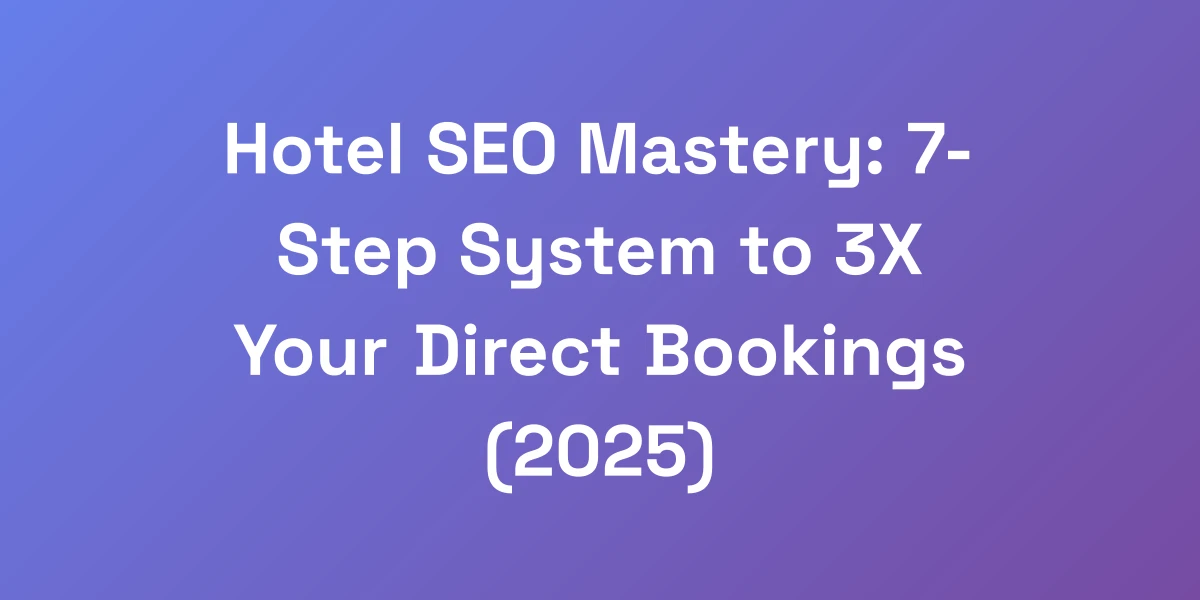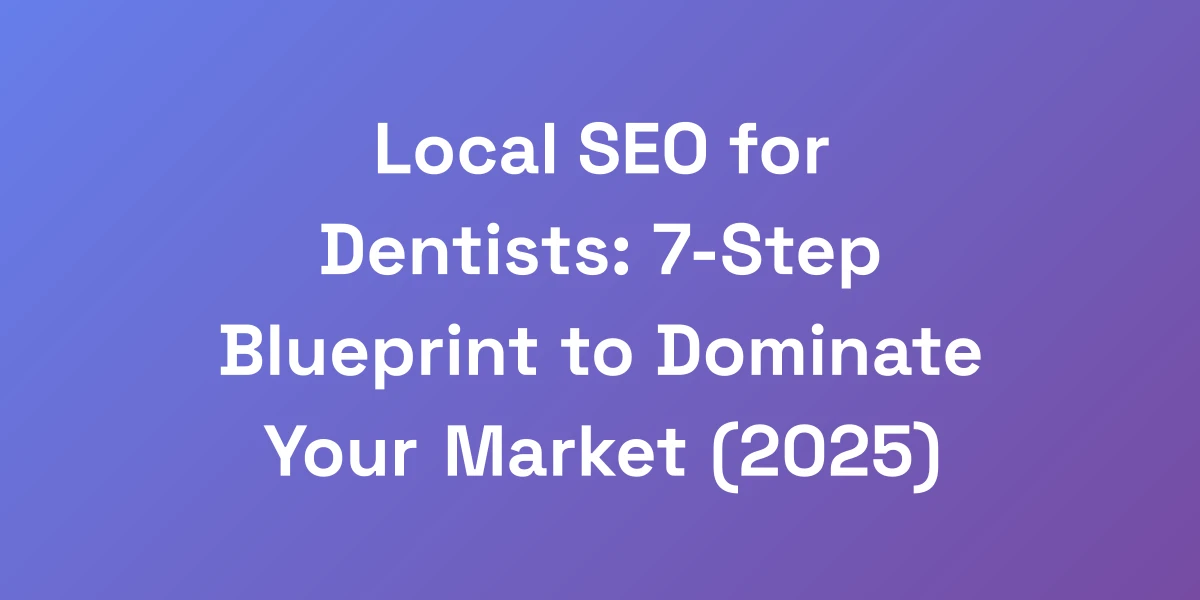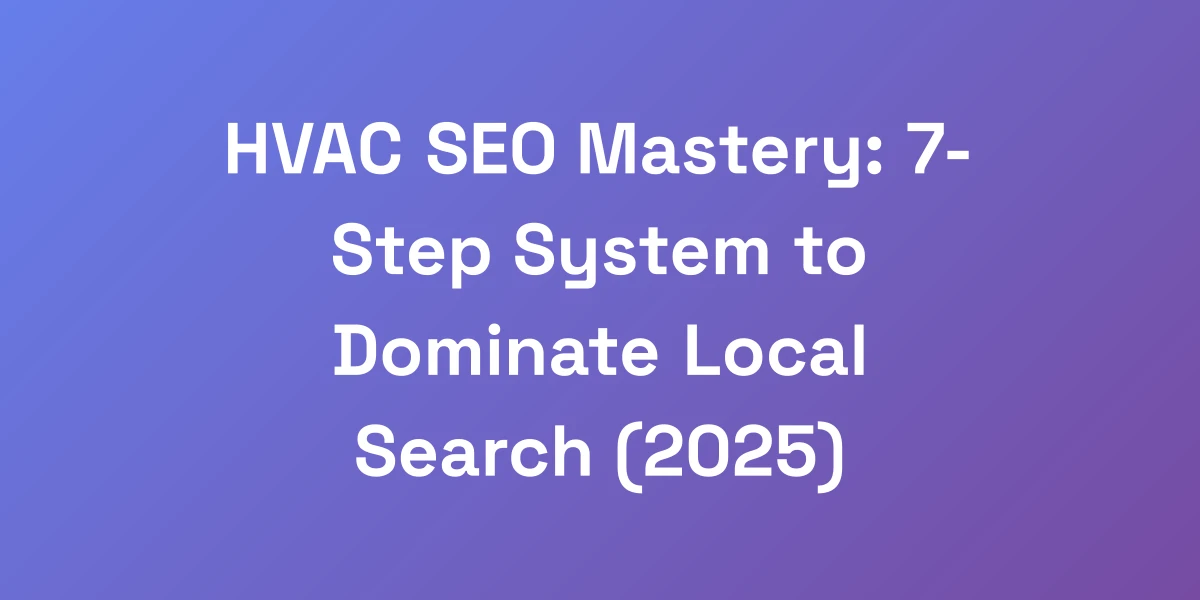
HVAC SEO Mastery: 7-Step System to Dominate Local Search (2025)
Mar 16, 2025 | By [email protected]
Introduction
Let’s cut to the chase: if your HVAC company isn’t dominating local search, you’re leaving money on the table. We’re not talking about sprinkling a few keywords here and there or chasing every backlink in sight. No, it’s deeper. It’s about mastering the art and science of SEO for HVAC companies in a way that positions you as the go-to expert in your community.
Think about it—97% of HVAC businesses are bleeding revenue because they’re stuck stuck in outdated SEO practices. While they’re fumbling with generic strategies, we’re here to show you a 7-step system that doesn’t just play the game but rules it. This isn’t fluff or jargon. It’s actionable, battle-tested tactics that transform your online presence from invisible to unstoppable. Ready to stop being just another listing and start becoming the first choice for anyone searching for HVAC services? Let’s dive in.
Why Most HVAC Companies Fail at SEO (And How to Win)
Let me be direct: 97% of HVAC companies are bleeding money by doing SEO wrong. They’re stuck playing checkers while their competitors are playing chess.
We’ve helped dozens of HVAC businesses go from invisible to dominating their local markets, and here’s the truth – it’s not about more content, more backlinks, or more technical BS. It’s about understanding the exact psychological triggers that make someone choose one HVAC company over another in search results. According to the US HVAC systems market analysis, staying ahead requires innovative strategies.
Let’s cut through the noise and get to what actually works.
The Traditional SEO Approach That’s Killing Your Business
Most HVAC companies mistakenly believe that quantity trumps quality. They churn out blog posts like there’s no tomorrow, obsess over backlinks without relevance, and drown in technical tweaks that offer little return.
Why is this approach failing? Because it ignores the human element. SEO isn’t just about pleasing algorithms; it’s about appealing to real people who are searching for your services. When you focus solely on traditional SEO tactics, you miss out on connecting with your audience on a psychological level.
Imagine throwing a party where you only care about the decorations but forget about the music and the food. Sure, it looks good, but no one stays. That’s your SEO right now—looks pretty, but nobody sticks around.
The New Psychology-Based SEO Framework
What if we shift our mindset from purely algorithm-driven SEO to a psychology-based SEO framework? It’s about tapping into the thought processes of your potential customers—their fears, desires, and decision-making triggers.
This new framework prioritizes content that speaks directly to the customer’s needs, builds trust through authoritative information, and strategically positions your services as the ultimate solution. It’s like having a conversation with your audience where every word is designed to guide them towards choosing you.
By understanding what makes your customers tick, we can craft an SEO strategy that not only ranks high but also converts browsers into loyal clients.
Real Numbers: Cost of Poor SEO in HVAC Industry
Let’s talk numbers. The cost of poor SEO practices is staggering. On average, businesses lose up to 30% of their potential revenue due to ineffective SEO strategies. According to Service Direct, understanding the cost of HVAC leads is crucial for budgeting your SEO efforts.
Consider an HVAC company that generates $500,000 annually. If poor SEO costs them just 30%, that’s a loss of $150,000 each year. These aren’t just missed opportunities; they’re tangible dollars slipping through your fingers because your online presence doesn’t align with consumer behavior.
But here’s the kicker—good SEO can turn this narrative around, not just recovering those lost revenues but exponentially increasing them.
Case Study: From Page 5 to Position #1 in 90 Days
Let’s look at Patrick Riley Cooling, Heating, & Plumbing. They were languishing on page 5 of search results, unseen by potential customers.
Within 90 days of implementing our 7-step system, they skyrocketed to position #1. How? We overhauled their entire SEO strategy—focusing on local optimization, revamping their Google Business Profile, and creating high-converting service pages. You can explore more HVAC case studies to see similar successes.
The result? A 35% increase in organic traffic and a significant boost in lead generation. This isn’t an isolated case; it’s a testament to the power of a well-executed SEO strategy tailored specifically for the HVAC industry.
The Local SEO Foundation: Setting Up Your Money-Making Machine
Before you even think about advanced strategies, you need to nail the fundamentals that actually move the needle. I’m talking about the 20% of SEO work that delivers 80% of the results. These strategies can be optimized using the best SEO tools for agencies.
Your Google Business Profile isn’t just a listing – it’s your 24/7 lead generation engine. Your website isn’t just a brochure – it’s your digital sales team.
We’re going to transform these basic tools into customer-acquiring assets that print money while you sleep.
Optimizing Google Business Profile for Maximum Visibility
Your Google Business Profile (GBP) is the cornerstone of local SEO. It’s your digital storefront where potential customers decide if you’re worth their business.
Here’s how to optimize it:
- Complete Every Section: Ensure your GBP is 100% complete with accurate NAP (Name, Address, Phone Number) details.
- Keywords Integration: Naturally incorporate your primary keywords, like HVAC repair and AC installation, into your business description.
- High-Quality Images: Upload professional photos of your team, projects, and premises to build trust and engagement.
- Regular Updates: Post updates about promotions, new services, or seasonal tips to keep your profile active and engaging.
- Utilize Q&A: Actively manage the Q&A section to address common customer inquiries and showcase your expertise.
By optimizing your GBP, you’re not just increasing visibility—you’re creating a direct channel for leads to find and contact you effortlessly.
Website Architecture That Converts Visitors into Customers
Your website’s architecture plays a critical role in converting visitors into customers. It’s not just about having a website; it’s about having a user-friendly and conversion-focused site.
Here’s how to structure it:
- Clear Navigation: Ensure your site is easy to navigate with a logical structure that guides visitors to key pages.
- Responsive Design: Your website must be mobile-optimized, considering that 76% of local searches are done on mobile devices.
- Fast Load Times: Optimize images and use efficient coding practices to ensure your site loads quickly.
- Strong CTAs: Use clear and compelling calls-to-action on every page to drive conversions.
- Trust Signals: Incorporate testimonials, certifications, and case studies to build credibility.
A well-structured website not only improves user experience but also enhances your SEO, making it easier for search engines to crawl and index your site effectively.
Local Citation Building That Actually Matters
Local citations are mentions of your business on other websites, and they’re essential for local SEO. But not all citations are created equal.
Focus on:
- Relevant Directories: List your business on reputable local and industry-specific directories.
- Consistent NAP: Ensure that your Name, Address, and Phone Number are consistent across all platforms.
- High-Quality Listings: Avoid low-quality or spammy directories that can harm your SEO.
- Engage with Local Publications: Get featured in local news sites or blogs to build authoritative citations.
Quality over quantity is key. Focus on building citations from sources that are trusted and relevant to your industry and location.
Content Strategy That Sells: Beyond “Tips and Tricks”
Stop writing boring blog posts about “5 Signs You Need AC Repair.” That’s amateur hour.
Your content strategy needs to be a direct response sales machine. Every piece of content should be engineered to trigger specific buying behaviors.
We’ll show you how to create content that doesn’t just rank – it pre-sells your services and positions you as the only logical choice for anyone searching for HVAC services? Let’s dive in.
High-Converting Service Pages Framework
Your service pages are the heart of your website’s conversion strategy. They need to do more than just explain what you do—they need to compel visitors to take action.
Here’s how:
- Clear Headlines: Use attention-grabbing headlines that immediately convey the benefit of your service.
- Benefit-Focused Content: Highlight how your services solve specific problems for your customers.
- Strong CTAs: Include clear and persuasive calls-to-action that guide visitors towards contacting you.
- Trust Elements: Add testimonials, case studies, and certifications to build credibility.
- Visuals and Media: Use images, videos, and infographics to make the page engaging and informative.
Optimized service pages can significantly boost your conversion rates by turning curious visitors into committed customers.
Local Content Topics That Drive Emergency Calls
Creating content around local issues and emergencies can drive immediate action from your audience. Think beyond generic tips and cater to the urgent needs of your community.
Consider topics like:
- Emergency HVAC Repairs for Summer Heatwaves: Provide actionable advice and promote your emergency services.
- Winter Heating Tips for Local Homes: Offer valuable insights while highlighting your heating solutions.
- Impact of Local Weather Patterns on HVAC Systems: Educate your audience and position your services as the solution.
Strategically timed and localized content can trigger emergency calls and drive immediate business opportunities.
Video Content Strategy for HVAC Companies
Video content is a powerful tool for engaging your audience and showcasing your expertise. It’s not just about creating videos; it’s about creating the right videos that drive conversions.
Here’s how to leverage video:
- Service Demonstrations: Show your team in action to build trust and demonstrate your expertise.
- Customer Testimonials: Feature satisfied customers sharing their positive experiences.
- How-To Guides: Create instructional videos that provide value and position you as a helpful resource.
- Behind-the-Scenes: Give a glimpse into your company culture and operations to humanize your brand.
Incorporating video content can significantly boost engagement, improve SEO, and convert viewers into customers.
Customer Journey Mapping in Content Creation
Understanding your customer’s journey is crucial for creating content that meets them at every stage of their decision-making process.
Here’s how to map it out:
- Awareness Stage: Create educational content that addresses common HVAC problems and solutions.
- Consideration Stage: Develop comparison guides and case studies that highlight your strengths.
- Decision Stage: Offer compelling calls-to-action, special offers, and easy ways to contact you.
By aligning your content with the customer journey, you ensure that you’re providing the right information at the right time, increasing the likelihood of conversion.
Seasonal Content Calendar Template
Maintaining a consistent flow of relevant content requires careful planning. A seasonal content calendar helps you stay organized and ensures you’re capitalizing on seasonal trends.
Here’s a basic template to get started:
- Winter: Heating system maintenance tips, emergency heating service promotions.
- Spring: Air conditioning tune-ups, spring cleaning for HVAC systems.
- Summer: Cooling system efficiency tips, emergency AC repair services.
- Fall: Preparing HVAC systems for winter, energy-saving strategies.
By planning your content around seasonal needs, you can stay relevant and top-of-mind for your customers year-round.
Technical SEO Weaponry for HVAC Websites
Look, I know technical SEO sounds about as exciting as watching paint dry. But here’s the reality – while your competitors are drowning in technical debt, you can use these simple but powerful optimizations to leapfrog them in search results.
We’re not going to cover every technical aspect – just the ones that deliver immediate ROI for HVAC businesses.
Page Speed Optimization for Service Areas
Page speed is a crucial ranking factor and directly impacts user experience. Slow-loading pages drive visitors away and hurt your SEO.
To optimize page speed:
- Compress Images: Use tools to reduce image sizes without sacrificing quality.
- Minimize JavaScript and CSS: Reduce the number of scripts and style sheets to speed up loading times.
- Use a Content Delivery Network (CDN): Distribute your content across various servers worldwide for faster access.
- Enable Browser Caching: Allow browsers to store parts of your website to speed up repeat visits.
Improving page speed not only enhances user experience but also boosts your search engine rankings.
Mobile-First Indexing Checklist
With Google now prioritizing mobile-first indexing, ensuring your website is optimized for mobile devices is non-negotiable.
Here’s a checklist:
- Responsive Design: Ensure your site adapts seamlessly to different screen sizes.
- Readable Text: Use legible font sizes and clear typography.
- Clickable Elements: Make buttons and links easy to tap without overlapping.
- Mobile-Friendly Navigation: Simplify your menu structure for easier access on mobile devices.
By adhering to a mobile-first approach, you ensure that your site performs well in search results and provides a great user experience.
Local Schema Markup Implementation
Schema markup enhances your website’s visibility in search results through rich snippets. For HVAC companies, local schema is particularly beneficial.
Implement the following:
- Organization Schema: Define your business details clearly for search engines.
- Service Schema: Mark up each HVAC service you offer to appear in relevant searches.
- Review Schema: Highlight customer reviews to improve click-through rates.
Proper schema markup can significantly improve your local SEO by making your listings more informative and appealing in search results.
XML Sitemap Strategy
Your XML sitemap is a roadmap for search engines, helping them index your website more efficiently. A well-structured sitemap ensures that all important pages are crawled and indexed.
Here’s how to optimize it:
- Include All Key Pages: Ensure every important service page and blog post is included.
- Keep It Updated: Regularly update your sitemap to reflect new content and changes.
- Submit to Google Search Console: Ensure your sitemap is submitted and monitored for any issues.
Maintaining a clean and comprehensive XML sitemap helps search engines navigate your site, improving your overall SEO performance.
Technical Audit Priorities
Regular technical audits are essential to identify and fix SEO issues that could be hindering your performance.
Focus on:
- Broken Links: Identify and fix 404 errors to maintain a smooth user experience.
- Duplicate Content: Ensure each page has unique content to avoid penalties.
- HTTPS Implementation: Secure your site with HTTPS to build trust and improve rankings.
- Structured Data: Regularly audit your schema markup to ensure it’s accurate and up-to-date.
Prioritizing these aspects in your technical audits ensures that your site remains healthy and optimized for search engines.
Local Link Building That Actually Works
Forget guest posting and directory submissions. Those strategies died years ago.
The new way to build authority is through strategic local partnerships and community presence.
We’re going to show you how to build powerful local links that not only boost your rankings but actually send you qualified leads. This is about building real relationships that translate into real revenue.
Strategic Local Partnership Framework
Building strategic local partnerships is about collaborating with other businesses and organizations in your community to create mutually beneficial relationships.
Steps to implement:
- Identify Potential Partners: Look for businesses that complement your services, such as real estate agents, construction firms, or home improvement stores.
- Collaborative Projects: Work on joint marketing campaigns, sponsor local events, or create bundled service offers.
- Exchange Backlinks: Feature each other on your websites or blogs to build valuable, authoritative backlinks.
These partnerships not only enhance your backlink profile but also increase your visibility within the community, driving more local traffic to your site.
Community Event Leverage Strategy
Participating in or sponsoring local events is a powerful way to build links and establish your presence in the community.
Here’s how to leverage community events:
- Event Sponsorship: Sponsor local sports teams, charity events, or community fairs to get mentioned on event websites.
- Host Workshops: Offer free HVAC maintenance workshops or informational seminars to position yourself as an expert.
- Event Partnerships: Partner with event organizers to be featured in promotional materials and event coverage.
These activities generate high-quality local backlinks and enhance your reputation as a community-focused business.
Competitor Link Analysis and Acquisition
Analyzing your competitors’ backlink profiles can uncover valuable link-building opportunities that you might have missed.
Steps to follow:
- Identify Top Competitors: Find out which HVAC companies in your area rank above you in search results.
- Analyze Their Backlinks: Use tools like Ahrefs or SEMrush to see where their links are coming from.
- Replicate and Improve: Reach out to the same sources and offer something better, like more comprehensive content or exclusive insights.
By understanding where your competitors are getting their links, you can strategically target similar opportunities to enhance your own backlink profile.
Press Release Distribution That Matters
Press releases can be an effective way to generate high-quality backlinks and boost your SEO when done correctly.
Here’s how to make it work:
- Newsworthy Content: Create press releases around significant company milestones, new service launches, or community initiatives.
- Targeted Distribution: Use reputable press release distribution services to ensure your news reaches local media and industry publications.
- SEO Optimization: Include relevant keywords and links back to your website to enhance SEO value.
Effective press releases can attract authoritative backlinks and increase your brand’s visibility in local search results.
Industry Association Opportunities
Joining and actively participating in industry associations can be a goldmine for building authoritative backlinks.
Here’s how to capitalize on it:
- Membership Listings: Ensure your business is listed on association websites, which are typically high-authority domains.
- Content Contributions: Write articles or contribute to newsletters and blogs hosted by the association.
- Event Participation: Speak at conferences or webinars organized by the association to gain exposure and backlinks.
These opportunities not only provide valuable backlinks but also establish you as a trusted authority in the HVAC industry.
Review Generation System on Autopilot
Reviews are the new currency in local SEO. But begging customers for reviews is beneath you.
Instead, we’ll show you how to build a systematic review generation machine that runs on autopilot. This isn’t just about getting more 5-star reviews – it’s about leveraging social proof to dominate local search and crush your competition.
Automated Review Request System
Automating the process of requesting reviews ensures consistency and maximizes the number of reviews you receive without manual effort.
Here’s how to set it up:
- Email Automation: Send follow-up emails after service completion thanking customers and requesting a review.
- SMS Requests: Use SMS to quickly and conveniently ask for reviews shortly after the service visit.
- CRM Integration: Integrate review requests into your CRM system to automatically trigger at the right time.
Automation keeps the process streamlined and ensures you’re regularly collecting valuable customer feedback.
Review Response Templates
Responding to reviews is crucial for building trust and showing that you value customer feedback.
Use these templates:
- Positive Reviews: Thank the customer, mention specific aspects they highlighted, and invite them back.
- Negative Reviews: Acknowledge the issue, apologize sincerely, and offer a solution or invite them to discuss further offline.
Having predefined templates makes it easier to manage reviews efficiently while maintaining a professional and responsive image.
Negative Review Management Protocol
Negative reviews can harm your reputation if not handled properly. Here’s a protocol to manage them:
- Immediate Response: Address negative feedback promptly to show that you care.
- Stay Professional: Keep your responses calm, courteous, and solution-oriented.
- Take Conversations Offline: Offer to resolve issues privately to prevent public disagreements.
- Learn and Improve: Use negative feedback to identify areas for improvement and enhance your services.
Properly managing negative reviews can turn dissatisfied customers into loyal advocates and demonstrate your commitment to excellence.
Review Schema Implementation
Implementing review schema helps showcase your reviews directly in search results, enhancing your visibility and credibility.
Steps to implement:
- Choose the Right Schema: Use the appropriate review schema type based on your content.
- Accurate Markup: Ensure that all review data is accurately marked up to avoid errors.
- Testing: Use Google’s Structured Data Testing Tool to verify your schema implementation.
Proper review schema can lead to rich snippets, making your listings more attractive and clickable in search results.
Review Monitoring and Analytics
Monitoring and analyzing your reviews is essential to understand customer sentiment and improve your services.
Here’s how to do it:
- Use Tools: Utilize review monitoring tools to track new reviews across platforms.
- Analyze Trends: Look for common themes and trends in feedback to identify strengths and areas for improvement.
- Report Insights: Regularly review analytics reports to measure the impact of your review management efforts.
Effective monitoring and analysis help you stay on top of customer sentiment and continuously enhance your service quality.
Measuring What Matters: ROI-Focused Analytics
Stop obsessing over rankings and start focusing on revenue. Most HVAC companies track vanity metrics that don’t matter.
We’re going to show you how to set up tracking that actually matters – leads, calls, and most importantly, revenue.
You’ll learn exactly how to measure the ROI of your SEO efforts and scale what works.
Google Analytics 4 Setup for HVAC
Google Analytics 4 (GA4) offers powerful tools for tracking user behavior and measuring the effectiveness of your SEO strategies.
Here’s how to get started:
- Set Up Goals: Define specific goals such as form submissions, phone calls, and service bookings.
- Event Tracking: Implement event tracking for key actions like button clicks and video views.
- Custom Dashboards: Create dashboards that focus on the metrics that matter most to your business.
Configuring GA4 correctly ensures you have accurate data to make informed decisions about your SEO and marketing efforts.
Call Tracking Implementation
Understanding which marketing efforts drive phone calls is crucial for measuring ROI.
Here’s how to implement call tracking:
- Unique Phone Numbers: Assign unique phone numbers to different marketing channels to track their performance.
- Integration with CRM: Link your call tracking system with your CRM to monitor call outcomes and follow-ups.
- Call Analytics: Analyze call data to identify trends and optimize your marketing strategies accordingly.
Call tracking provides valuable insights into the effectiveness of your SEO efforts by linking online activities to real-world outcomes.
Lead Attribution Modeling
Understanding which SEO activities contribute most to your leads helps you allocate resources effectively.
Here’s how to set it up:
- Multi-Touch Attribution: Assign value to multiple touchpoints in the customer journey to get a complete picture of lead generation.
- First and Last Interaction: Track both the first interaction that brought the lead in and the last one before conversion.
- Custom Models: Develop custom attribution models tailored to your specific business needs and customer behavior.
Effective attribution modeling ensures you’re investing in the strategies that deliver the highest returns.
Competitor Performance Tracking
Keeping an eye on your competitors’ performance can provide valuable insights and help you stay competitive.
Here’s how to track competitor performance:
- SEO Tools: Use tools like SEMrush or Ahrefs to monitor your competitors’ keyword rankings and backlink profiles.
- Benchmarking: Compare your performance metrics against your top competitors to identify gaps and opportunities.
- Strategy Analysis: Analyze their content and link-building strategies to uncover tactics that you can implement or improve upon.
Regular competitor tracking helps you stay ahead and continuously refine your SEO strategies for maximum impact.
Monthly Reporting Templates
Consistent reporting keeps you informed about the performance of your SEO efforts and helps you make data-driven decisions.
Here’s what to include in your monthly reports:
- Traffic Metrics: Track organic traffic, page views, and user behavior.
- Lead Metrics: Monitor form submissions, phone calls, and other lead generation activities.
- Conversion Rates: Measure the percentage of visitors who take desired actions on your site.
- ROI Analysis: Calculate the return on investment for your SEO campaigns to ensure they’re delivering value.
Well-structured monthly reports provide a clear view of your SEO performance, allowing you to adjust strategies and maximize ROI.
Conclusion
There you have it—a comprehensive, 7-step system to master SEO for HVAC companies and dominate local search in 2025. We’ve covered everything from laying a solid local SEO foundation to implementing advanced strategies that drive real, measurable results.
Remember, it’s not just about ranking higher; it’s about attracting the right customers and converting them into loyal clients. With the actionable tips and strategies outlined here, you’re well on your way to transforming your online presence and skyrocketing your business growth.
Ready to take your HVAC company to the next level? Start implementing these steps today and watch your local search dominance unfold. Got questions or need further guidance? Drop a comment below or reach out to us directly. Let’s build something extraordinary together.
